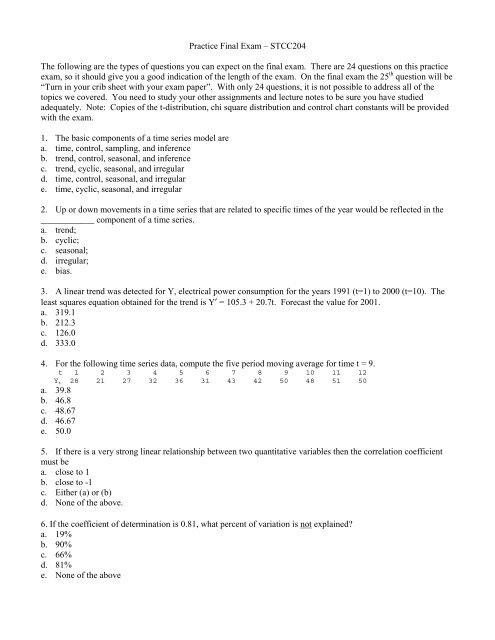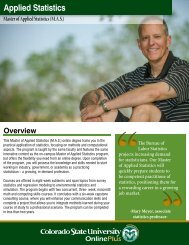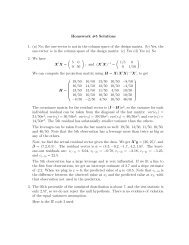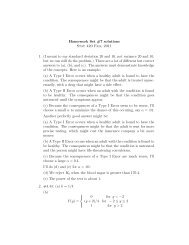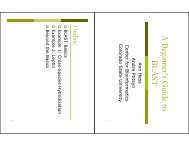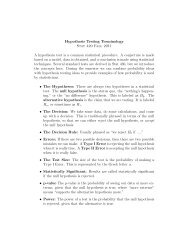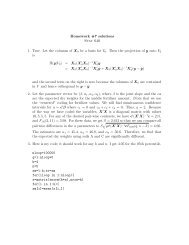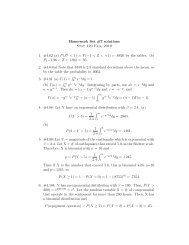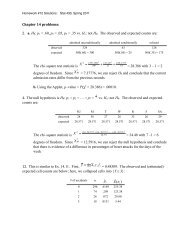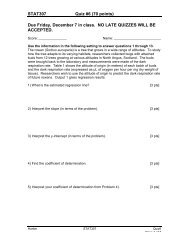Practice Final Exam â STCC204 The following are the ... - Statistics
Practice Final Exam â STCC204 The following are the ... - Statistics
Practice Final Exam â STCC204 The following are the ... - Statistics
You also want an ePaper? Increase the reach of your titles
YUMPU automatically turns print PDFs into web optimized ePapers that Google loves.
<strong>Practice</strong> <strong>Final</strong> <strong>Exam</strong> – <strong>STCC204</strong><br />
<strong>The</strong> <strong>following</strong> <strong>are</strong> <strong>the</strong> types of questions you can expect on <strong>the</strong> final exam. <strong>The</strong>re <strong>are</strong> 24 questions on this practice<br />
exam, so it should give you a good indication of <strong>the</strong> length of <strong>the</strong> exam. On <strong>the</strong> final exam <strong>the</strong> 25 th question will be<br />
“Turn in your crib sheet with your exam paper”. With only 24 questions, it is not possible to address all of <strong>the</strong><br />
topics we covered. You need to study your o<strong>the</strong>r assignments and lecture notes to be sure you have studied<br />
adequately. Note: Copies of <strong>the</strong> t-distribution, chi squ<strong>are</strong> distribution and control chart constants will be provided<br />
with <strong>the</strong> exam.<br />
1. <strong>The</strong> basic components of a time series model <strong>are</strong><br />
a. time, control, sampling, and inference<br />
b. trend, control, seasonal, and inference<br />
c. trend, cyclic, seasonal, and irregular<br />
d. time, control, seasonal, and irregular<br />
e. time, cyclic, seasonal, and irregular<br />
2. Up or down movements in a time series that <strong>are</strong> related to specific times of <strong>the</strong> year would be reflected in <strong>the</strong><br />
____________ component of a time series.<br />
a. trend;<br />
b. cyclic;<br />
c. seasonal;<br />
d. irregular;<br />
e. bias.<br />
3. A linear trend was detected for Y, electrical power consumption for <strong>the</strong> years 1991 (t=1) to 2000 (t=10). <strong>The</strong><br />
least squ<strong>are</strong>s equation obtained for <strong>the</strong> trend is Y′ = 105.3 + 20.7t. Forecast <strong>the</strong> value for 2001.<br />
a. 319.1<br />
b. 212.3<br />
c. 126.0<br />
d. 333.0<br />
4. For <strong>the</strong> <strong>following</strong> time series data, compute <strong>the</strong> five period moving average for time t = 9.<br />
t 1 2 3 4 5 6 7 8 9 10 11 12<br />
Y t 28 21 27 32 36 31 43 42 50 48 51 50<br />
a. 39.8<br />
b. 46.8<br />
c. 48.67<br />
d. 46.67<br />
e. 50.0<br />
5. If <strong>the</strong>re is a very strong linear relationship between two quantitative variables <strong>the</strong>n <strong>the</strong> correlation coefficient<br />
must be<br />
a. close to 1<br />
b. close to -1<br />
c. Ei<strong>the</strong>r (a) or (b)<br />
d. None of <strong>the</strong> above.<br />
6. If <strong>the</strong> coefficient of determination is 0.81, what percent of variation is not explained?<br />
a. 19%<br />
b. 90%<br />
c. 66%<br />
d. 81%<br />
e. None of <strong>the</strong> above
7. <strong>The</strong> term extrapolation refers to<br />
a. using <strong>the</strong> sample regression equation to predict or estimate a value of Y using a value for X that is not within<br />
<strong>the</strong> range of <strong>the</strong> X-values in <strong>the</strong> sample.<br />
b. using a straight line regression equation to represent data that show a non-linear relationship between <strong>the</strong> two<br />
variables.<br />
c. using a least squ<strong>are</strong>s regression equation when <strong>the</strong> residuals <strong>are</strong> not normally distributed<br />
d. using a regression equation when <strong>the</strong> sub-populations of Y-values do not have equal standard deviations.<br />
e. None of <strong>the</strong> above.<br />
8. <strong>The</strong> measure that indicates <strong>the</strong> amount of dispersion of <strong>the</strong> observed values about <strong>the</strong> regression line is denoted<br />
a. s Y·X<br />
b. Y′<br />
c. a<br />
d. b<br />
e. None of <strong>the</strong> above<br />
9. In regression analysis, which of <strong>the</strong> <strong>following</strong> is not a required assumption?<br />
a. <strong>The</strong> means of <strong>the</strong> sub-populations of Y-values all fall on a line.<br />
b. <strong>The</strong> standard deviations of <strong>the</strong> sub-populations <strong>are</strong> all equal.<br />
c. <strong>The</strong> Y-values <strong>are</strong> independent.<br />
d. <strong>The</strong> sub-populations <strong>are</strong> normally distributed.<br />
e. All of <strong>the</strong> above <strong>are</strong> required assumptions.<br />
10. An economist wanted to investigate <strong>the</strong> relationship between monthly long distance phone charges and monthly<br />
income. He collected data for last month from a simple random sample of 40 households in <strong>the</strong> Denver <strong>are</strong>a. In<br />
particular, he recorded <strong>the</strong> long distance phone charges for that month (Y) and <strong>the</strong> monthly income (X). <strong>The</strong><br />
economist computed a regression equation and a correlation coefficient. Residuals were computed to check <strong>the</strong><br />
regression assumptions. <strong>The</strong>se residuals <strong>are</strong><br />
a. differences between <strong>the</strong> observed monthly income and <strong>the</strong> predicted monthly income using <strong>the</strong> regression<br />
equation<br />
b. <strong>the</strong> difference between <strong>the</strong> observed degrees of freedom and <strong>the</strong> actual degrees of freedom<br />
c. <strong>the</strong> values obtained by predicting <strong>the</strong> long distance phone charges for each monthly income observed in <strong>the</strong><br />
sample<br />
d. <strong>the</strong> values obtained by computing a prediction interval for each monthly income observed in <strong>the</strong> sample<br />
e. differences between <strong>the</strong> observed long distance charges and <strong>the</strong> charges predicted using <strong>the</strong> regression equation<br />
11. A regression model was fit to predict bear age using weight as <strong>the</strong> independent variable and <strong>the</strong> Minitab output<br />
is shown below. Based on this output, what can be concluded about <strong>the</strong> correlation between age and weight?<br />
<strong>The</strong> regression equation is<br />
Age = 2.61 + 0.219 Weight<br />
Predictor Coef SE Coef T P<br />
Constant 2.613 4.408 0.59 0.555<br />
Weight 0.21912 0.01992 11.00 0.000<br />
S = 21.68 R-Sq = 59.9% R-Sq(adj) = 59.4%<br />
a. <strong>The</strong> correlation is positive.<br />
b. <strong>The</strong> correlation is negative.<br />
c. <strong>The</strong> correlation is equal to 0.599<br />
d. <strong>The</strong> correlation is equal to 0.219.<br />
e. Age and weight <strong>are</strong> weakly correlated.
12. A regression model was fit to predict bear age using weight as <strong>the</strong> independent<br />
variable. A residual plot is shown here. Based on this plot, we can conclude that<br />
<strong>the</strong> <strong>following</strong> assumption of regression is violated<br />
a. For each value of X, <strong>the</strong>re is a group of Y values, and <strong>the</strong>se Y value <strong>are</strong> normally<br />
distributed.<br />
b. <strong>The</strong> means of <strong>the</strong> normal distributions of <strong>the</strong> Y values all lie on <strong>the</strong> straight line<br />
of regression.<br />
c. <strong>The</strong> standard deviations of <strong>the</strong>se normal distributions <strong>are</strong> equal.<br />
d. <strong>The</strong> Y values <strong>are</strong> statistically independent.<br />
e. This is impossible to determine without knowing <strong>the</strong> sample size.<br />
Residual<br />
80<br />
60<br />
40<br />
20<br />
0<br />
-20<br />
-40<br />
0<br />
Residuals Versus <strong>the</strong> Fitted Values<br />
(response is Age)<br />
50<br />
100<br />
Fitted Value<br />
13. A study was performed to investigate <strong>the</strong> strength of <strong>the</strong> linear relationship between Y, squ<strong>are</strong> footage of a home and X,<br />
<strong>the</strong> income of <strong>the</strong> residents. A sample of 10 homes was obtained, resulting in a correlation coefficient equal to 0.843. In<br />
testing at <strong>the</strong> .01 significance level whe<strong>the</strong>r or not <strong>the</strong>re is a linear relationship between Y and X, <strong>the</strong> decision would be<br />
a. Reject H 0 , since t > 2.896 or t 3.355 or t 4.432 or t 2.764 or t 3.169 or t
17. A food company uses filling machines to package 12 ounce boxes of a certain type of breakfast cereal. <strong>The</strong><br />
variability in this process is due to chance causes only. This process is said to be<br />
a. changable<br />
d. in control<br />
b. assignable<br />
e. None of <strong>the</strong> above.<br />
c. out of control<br />
18. <strong>The</strong> owner of a grounds-keeping service wants to identify <strong>the</strong> reasons why past clients discontinued service<br />
with his company. Given below is a P<strong>are</strong>to chart for data <strong>the</strong> owner collected from clients who discontinued<br />
service in <strong>the</strong> past year. <strong>The</strong> categories <strong>are</strong>:<br />
1-too expensive<br />
2-dissatisfied with quality of service<br />
3-moved<br />
4-too many missed appointments<br />
5-o<strong>the</strong>r<br />
Based on this chart, which of <strong>the</strong> <strong>following</strong><br />
statements <strong>are</strong> true for <strong>the</strong> 39 clients<br />
represented in <strong>the</strong> chart?<br />
1) Expense is <strong>the</strong> most frequent<br />
reason for discontinuing service.<br />
2) Customer dissatisfaction with<br />
service accounts for 71.8% of <strong>the</strong><br />
reasons for discontinuing sevice.<br />
3) <strong>The</strong> “o<strong>the</strong>r” category accounts for<br />
<strong>the</strong> largest percentage of <strong>the</strong><br />
reasons for discontinuing service.<br />
a. 1,2 and 3<br />
b. 2 only<br />
c. 1 and 2<br />
d. 1 and 3<br />
e. 1 only<br />
Count<br />
40<br />
30<br />
20<br />
10<br />
0<br />
Defect 1 2 3 4 5<br />
Count<br />
Percent<br />
Cum %<br />
P<strong>are</strong>to Chart for Defect<br />
16 12 5 3 3<br />
41.0 30.8 12.8 7.7 7.7<br />
41.0 71.8 84.6 92.3 100.0<br />
19. In a production process, four items were sampled every hour to set up a control chart for <strong>the</strong> process. <strong>The</strong><br />
initial information obtained is shown below.<br />
Measurement<br />
Time 1 2 3 4<br />
9 a.m. 1.0 4.0 5.0 2.0<br />
10 a.m. 2.0 3.0 2.0 1.0<br />
11 a.m. 1.0 7.0 3.0 5.0<br />
What <strong>are</strong> <strong>the</strong> control limits for <strong>the</strong> mean chart?<br />
a. 5.916 and 0<br />
b. 5.916 and 0.084<br />
c. 0.729 and 3.0<br />
d. 3.0 and 4.0<br />
20. <strong>The</strong> manufacturing of circuit boards involves a process in which gold plating is placed on each board. To<br />
monitor <strong>the</strong> thickness of <strong>the</strong> gold plating on <strong>the</strong> circuit boards, ten samples of 4 gold plating thickness<br />
measurements were obtained. Using <strong>the</strong>se ten samples, an R-chart was obtained. All of <strong>the</strong> points on <strong>the</strong> R-chart<br />
fell between <strong>the</strong> control limits, and <strong>the</strong> chart showed no pattern. What can be said regarding <strong>the</strong> variability of <strong>the</strong><br />
process, based on <strong>the</strong> control chart?<br />
a. <strong>The</strong> process is in control.<br />
b. <strong>The</strong> process is not in control.<br />
c. Nothing can be determined, since <strong>the</strong> chart is not appropriate for investigating variability.<br />
d. Nothing can be determined, since <strong>the</strong> chart is not used for quality control.<br />
100<br />
80<br />
60<br />
40<br />
20<br />
0<br />
Percent
21. Which of <strong>the</strong> <strong>following</strong> is not true about <strong>the</strong> chi squ<strong>are</strong> distribution when used to test whe<strong>the</strong>r two qualitative variables <strong>are</strong><br />
related.<br />
a. It is based on <strong>the</strong> sample size.<br />
b. It is non-negative.<br />
c. It is positively skewed.<br />
d. When degrees of freedom change a new distribution is created.<br />
22. A small college offers students complete freedom of choice when registering for courses. This semester <strong>the</strong>re were seven<br />
sections of a particular ma<strong>the</strong>matics course. <strong>The</strong> sections were scheduled to meet at various times with a variety of instructors.<br />
<strong>The</strong> table below shows <strong>the</strong> number of students who selected each of <strong>the</strong> seven sections. Do <strong>the</strong> data indicate that <strong>the</strong> students<br />
had a preference for certain sections, or do <strong>the</strong>y indicate that each section was equally likely to be chosen? Note: <strong>The</strong><br />
calculated value for <strong>the</strong> test statistic equals 12.94. Use a .10 significance level.<br />
Section<br />
1 2 3 4 5 6 7 Total<br />
Number of Students 18 12 25 23 8 19 14 119<br />
a. Fail to reject H 0 and conclude that class sections <strong>are</strong> not equally likely.<br />
b. Fail to reject H 0 and conclude that class sections could be equally likely.<br />
c. Reject H 0 and conclude that class sections <strong>are</strong> not equally likely.<br />
d. Reject H 0 and conclude that class sections could be equally likely.<br />
23. A video store chain in Colorado wishes to comp<strong>are</strong> movie preferences for men and women. A random sample of 350<br />
video store customers were asked what type of movie <strong>the</strong>y most preferred. <strong>The</strong> responses <strong>are</strong> listed in <strong>the</strong> <strong>following</strong><br />
contingency table.<br />
Comedy Adventure Drama Horror Sci-Fi Total<br />
Men 34 35 26 25 74 194<br />
Women 35 17 57 25 22 156<br />
Total 69 52 83 50 96 350<br />
Compute <strong>the</strong> expected frequency for women who prefer drama, when testing whe<strong>the</strong>r movie preference and gender <strong>are</strong> related.<br />
a. 57.00<br />
b. 41.29<br />
c. 36.99<br />
d. 46.65<br />
e. None of <strong>the</strong> above.<br />
24. For <strong>the</strong> above problem, <strong>the</strong> <strong>following</strong> results were obtained using Minitab:<br />
Chi-Sq = 0.471 + 1.324 + 8.700 + 0.266 + 8.122 +<br />
0.586 + 1.646 + 10.819 + 0.331 + 10.100 = 42.364<br />
What is <strong>the</strong> decision of <strong>the</strong> test is <strong>the</strong> significance level is .05?<br />
a. Reject H 0 and conclude that movie preference and gender <strong>are</strong> related.<br />
b. Reject H 0 and conclude that movie preference and gender <strong>are</strong> not related<br />
c. Fail to reject H 0 and conclude that movie preference and gender <strong>are</strong> related<br />
d. Fail to reject H 0 and conclude that movie preference and gender <strong>are</strong> not related<br />
Answer Key - <strong>Practice</strong> <strong>Final</strong> <strong>Exam</strong><br />
1. c<br />
14. b<br />
2. c<br />
15. c<br />
3. d<br />
16. b<br />
4. b<br />
17. d<br />
5. c<br />
18. e<br />
6. a<br />
19. b<br />
7. a<br />
20. a<br />
8. a<br />
21. a<br />
9. e<br />
22. c<br />
10. e<br />
11. a<br />
23. c<br />
24. a<br />
12. c<br />
13. b


